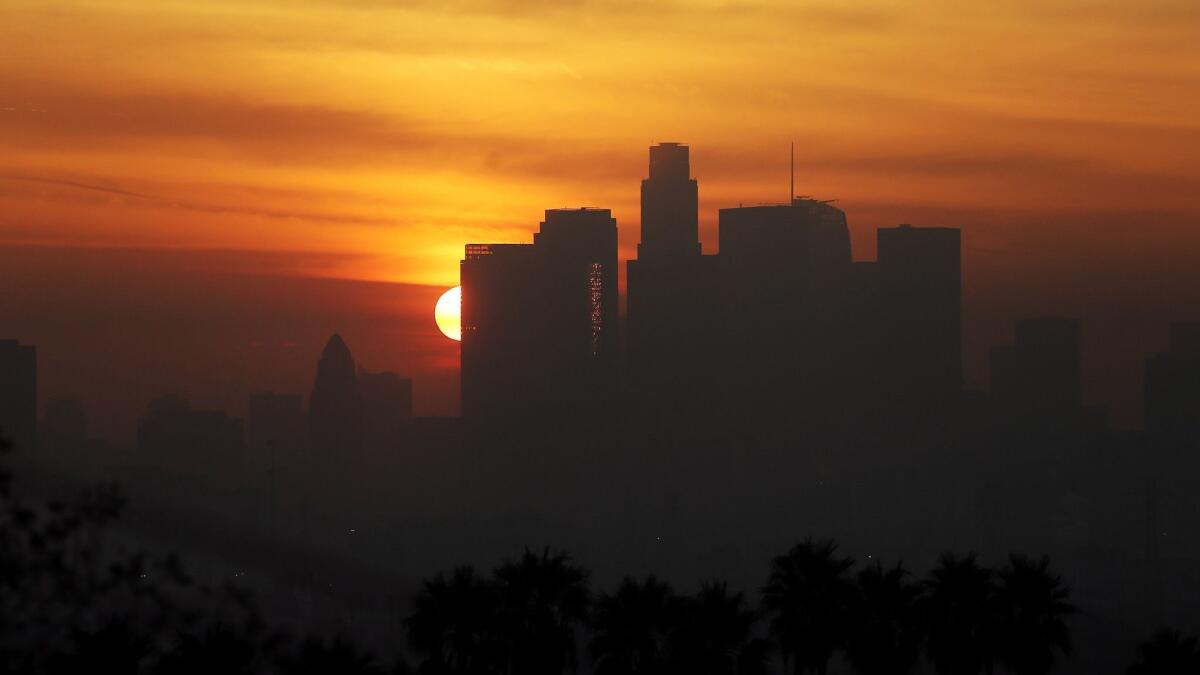Editorial: L.A. wasn’t built in the desert, but the desert may be coming to us

- Share via
It’s hard out there for an environmentally responsible but thirsty Angeleno — someone who wants to grow a couple organic tomatoes in the backyard, take more than an occasional shower and still have enough money to repair the rain barrel after paying the various water bills, fees and taxes. Measure W, which voters passed on Nov. 6, will help. But it won’t put an end to our water problems.
The principal challenge is no longer growth, at least not here in Southern California. L.A. is pretty efficient: Total residential water use here has held steady through the last couple of decades despite a growing population. We use less per flush, and although there are still an imponderably large number of sponge-damp, emerald green lawns sucking up too many acre-feet of imported water, more residents and businesses have come to appreciate the handsome palettes and textures of agaves and native California sages and buckwheats.
No, the problem now is climate change, a factor unseen and unknown when the state’s ambitious water distribution system was developed in the 20th century. It’s hitting our supply in three places, the first of which is right here at home.
Of the many nasty names that L.A. has been called by our snooty friends and neighbors, the nastiest is “desert.” Our exasperated and honest response has always been that no, we are not a desert. We have a Mediterranean climate. Check the rainfall totals. Average annual precipitation in Los Angeles is around 15 inches, well above the 10-inch cutoff that is a common definition of desert.
Cities can thrive in the desert. Look at Cairo, with virtually no rainfall, but a ready supply of water from the Nile.
But on a warming planet, the climate zones shift. L.A. was not built in the desert, but the desert may be coming to us. We’ve had a worrisome number of dry winters. The desiccated ground beneath us was an important factor in the deadly Malibu and Woolsey fires.
Still, cities can thrive in the desert. Look at Cairo, with virtually no rainfall, but a ready supply of water from the Nile. We have our rivers too, artificially extended though they may be.
But that brings us to the second location where climate change is cutting our water supply. The upper and lower Colorado River basins have been in a drought for close to two decades; Lake Mead behind Hoover Dam is only 38% full, and it’s unlikely to fill again. The lake is fed from upstream by Lake Powell, which is similarly depleted. Under a drought contingency plan negotiated with other Southwest states, California will take less Colorado River water than it gets now.
Third, the sources of the water we import from both sides of the Sierra are being dried up by climate change and overuse.
Environmentally oriented water thinkers have argued for years that the answer to L.A.’s threatened water supply is to reuse what we already have — to sanitize and purify what we flush, and to capture and clean what we currently let slip away down the storm drain.
Enter the Fray: First takes on the news of the minute from L.A. Times Opinion »
Measure W is an important, but tiny, step in that direction. Parcel tax proceeds will pay for projects to clean up the urban drool that runs off of lawns and driveways during the dry season, and the stormwater that otherwise would rush down concrete channels to the ocean after heavy rains. The primary objective is to put the region in compliance with clean water laws. But the amount of actual usable water we recoup from those projects is speculative.
L.A. is on the right track, but it will have to move faster and even more purposefully if it is to avoid running out of water. Residents ought to keep a keen eye on Measure W project proposals, and should be prepared to ask of each, “How much water will we get out of this?”
Follow the Opinion section on Twitter @latimesopinion and Facebook
More to Read
A cure for the common opinion
Get thought-provoking perspectives with our weekly newsletter.
You may occasionally receive promotional content from the Los Angeles Times.









